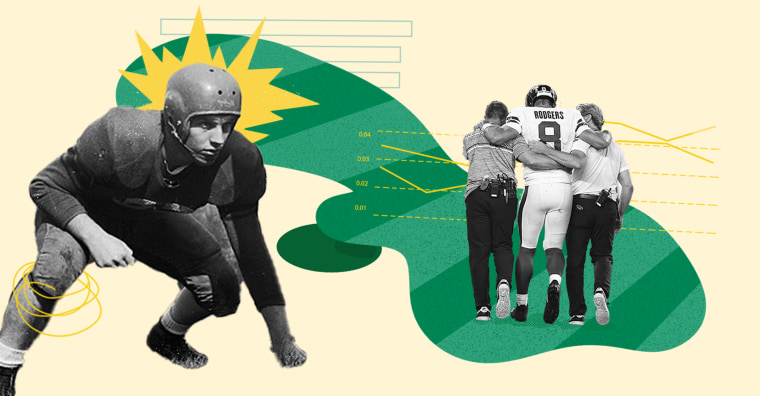When New York Jets quarterback Aaron Rodgers collapsed on the MetLife Stadium field with a season-ending Achilles tendon tear during the team’s first game, he reignited a debate over the safety of artificial turf. And while the NFL has maintained that turf fields are as safe as grass, new data provided to NBC News shows NFL stadiums with synthetic surfaces usually have more injuries.
Data from the sports analytics company Sports Info Solutions — which provides data and analysis to pro sports teams and other industry groups — shows that 7 of the 10 stadiums with the highest injury counts from 2017 to 2022 had artificial surfaces.
That data echoes findings from an NFL Players Association study that found higher injury rates on artificial turf every season from 2015 to 2022.
Further Sports Info Solutions analysis showed players were more likely to suffer injuries that required them to leave play on synthetic turf, and it found more turf injuries across many body parts.
The higher injury rates aren’t just at the NFL level, either. A study conducted by researchers at Washington University in St. Louis observed that high school athletes across 26 schools were 58% more likely to sustain injuries on artificial turf than on natural grass.
Elevated risk for injury was pronounced, “especially in athletes who participated in football, soccer and rugby,” said one of the study’s researchers, Dr. Derrick Knapik, an orthopedic sports medicine surgeon at Washington University.
While Knapik cautioned that high school players may be more injury-prone because of less conditioning and finesse, he noted that artificial turf has a stickiness that can catch the foot in a way natural grass might not.
“If that foot sticks,” Knapik warned, “that’s going to increase the risk of injuries not only to the foot and the ankle but as well as the knees and potentially the hip and torso.”
The NFL, when reached for comment, provided a statement from Jeff Miller, its executive vice president who oversees player health and safety.
“The playing surface is one factor among many that contributes to the number of injuries at any stadium. Each injury sustained by players is unique, with contributing factors, including injury history, the type of contact on the play, a player’s pose or movements, cleat type and more,” Miller said. “The NFL is actively working and collaborating with the NFLPA and jointly appointed experts to drive down injury rates on all types of surfaces.”
The NFLPA declined to comment. The union president, JC Tretter, has previously called grass “significantly safer” than synthetic turf fields.
Experts agree. “I am in the camp that a good grass field is the gold standard that we are trying to get artificial turf to emulate,” said Raoul Reiser II, an associate professor of health and exercise science at Colorado State University, whose research focuses on athletic performance and injury risk when the foot meets the ground.
“I believe the NFLPA in their interpretation of the injury statistics, that risk for lower extremity injuries is higher on artificial turf than natural grass. I also believe them when they say that they feel more beat up and sore after practice and games on artificial turf compared to natural grass.”
CORRECTION (Sept. 24, 9:04 a.m. ET): A previous version of this article misstated Aaron Rodgers’ injury. It is an Achilles tendon tear, not an ACL injury.
